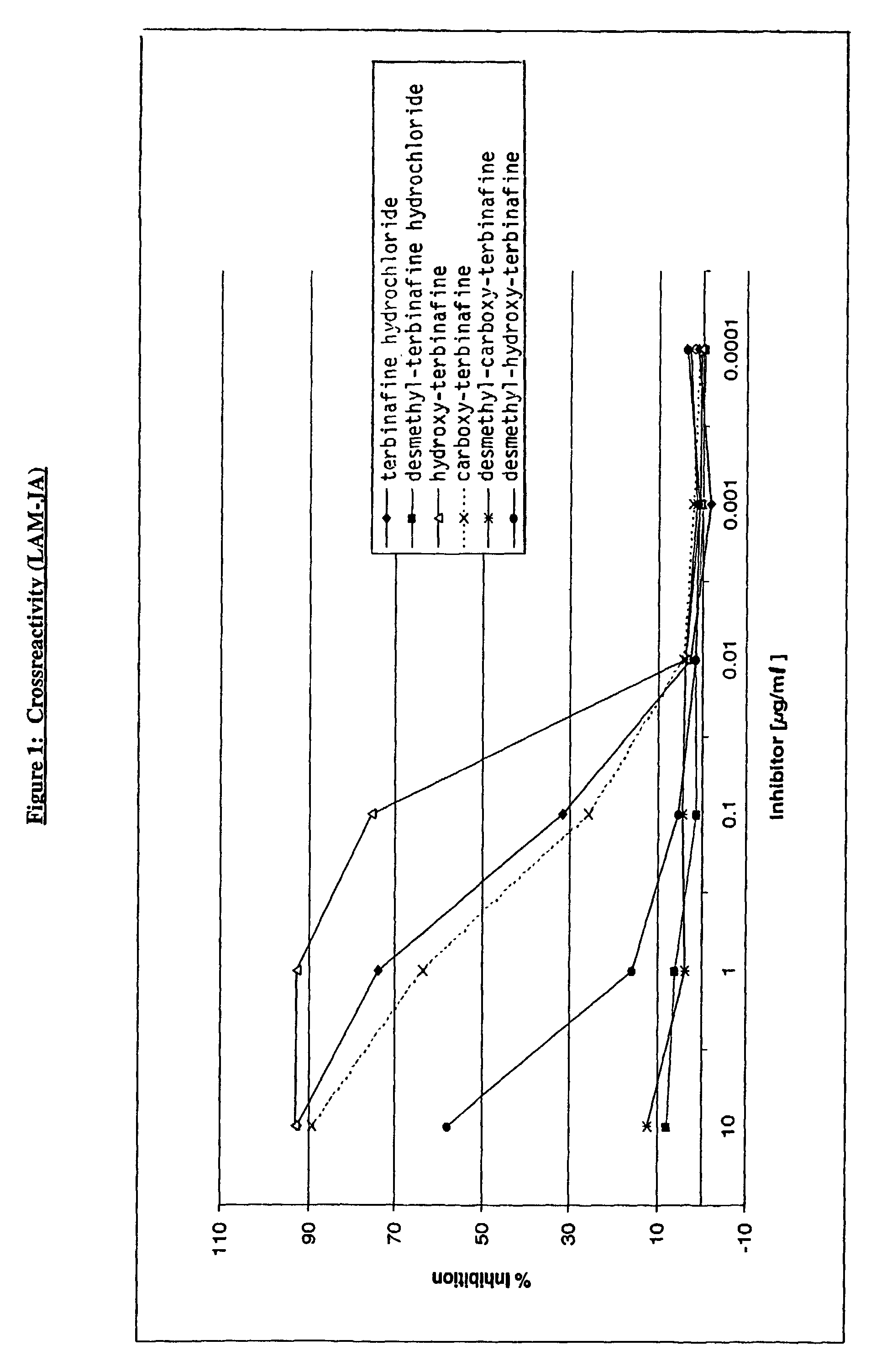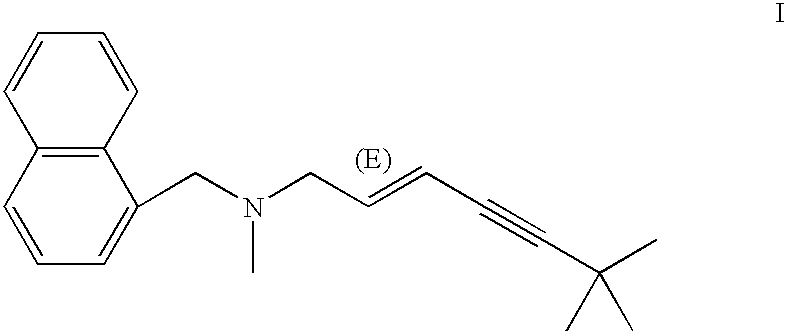Specific monoclonal antibody against terbinafine
a monoclonal antibody and terbinafine technology, applied in the field of monoclonal antibodies, can solve the problems of difficult immunological detection of drugs, no reports in the literature describing strong immune responses,
- Summary
- Abstract
- Description
- Claims
- Application Information
AI Technical Summary
Benefits of technology
Problems solved by technology
Method used
Image
Examples
example 1
Protein Conjugates of Carboxy-terbinafine
[0036]4.02 mg carboxy-terbinafine (m.p. 118–120°) is dissolved in 200 μl of DMSO and 800 μl of conjugation buffer (Imject®EDC Conjugation Kit, Pierce) is added carefully to the hapten solution. 500 μl of this mixture is added dropwise with vigorous stirring to the appropriate protein solution (protein concentration 2 mg / ml) of BSA or OVA. Each of the resultant protein-hapten solution (500 μl) is added to 10 mg EDC. The reaction mixture is stirred for 3 hours at room temperature and the resultant conjugates are purified by dialysis at 4° against 41 of PBS, twice over 24 hours. The resultant conjugates (terbinafine-OVA; terbinafine-BSA) are aliquoted and stored at −18°.
example 2
Production of Monoclonal Antibody
[0037]Female Balb / C mice (20–25 g) each receive 100 μg carboxy-terbinafine conjugate covalently linked to OVA according to Example 1, in complete Freund adjuvant, administered by i.p. injection. After 5 and 10 weeks a first and second boost comprising one half of the initial amount of the immunogenic conjugate emulsified in incomplete Freund adjuvant is administered by i.p. injection. Direct ELISA (see below) is used to confirm the presence of antibodies reactive to the antigen in the animals' blood serum. After 13 weeks mice receive the third boost by i.p. injection, and ten days later mice receive booster injections comprising 50 μg of the antigen i.v. on days −3, −2 and −1. On day +1 mice are sacrificed and their spleen cells are isolated and fused with e.g. PAI-0 cells or other suitable myeloma line. The resulting hybridoma are cultured and selected using ELISA for expression of antibody having a high affinity to terbinafine. After selection of t...
example 3
Selection of Antibodies by Direct ELISA for Terbinafine
[0038]Microtiter plates are coated with 5 μg / ml terbinafine hydrochloride—protein (BSA) conjugate in carbonate buffer overnight at 4°, then saturated with blocking reagent [SuperBloc® buffer (Pierce)] and washed 3× with 0.05% (v / v) PBS-TWEEN® (polyoxyethylene 20 sorbitan monoleate). The hybridoma supernatants to be screened are diluted in a 1% (w / v) solution of BSA in PBS-TWEEN® (polyoxyethylene 20 sorbitan monoleate), and incubated for 2 hours at 37°. Level of bound antibody is measured by anti-mouse IgG rabbit immunoglobulin coupled to horseradish peroxidase with OPD as the substrate. After incubation for one hour at room temperature the enzymatic substrate is hydrolyzed and absorbance at 490 / 650 nm is measured after 15 minutes incubation in the dark.
[0039]Based on this test the hybridoma cell line designated LAM-JA (11H2.F9.C4) (producing antibody of sublclass IgG2a λ) obtained from Example 2 was selected for antibody product...
PUM
| Property | Measurement | Unit |
|---|---|---|
| Concentration | aaaaa | aaaaa |
Abstract
Description
Claims
Application Information
 Login to View More
Login to View More - R&D
- Intellectual Property
- Life Sciences
- Materials
- Tech Scout
- Unparalleled Data Quality
- Higher Quality Content
- 60% Fewer Hallucinations
Browse by: Latest US Patents, China's latest patents, Technical Efficacy Thesaurus, Application Domain, Technology Topic, Popular Technical Reports.
© 2025 PatSnap. All rights reserved.Legal|Privacy policy|Modern Slavery Act Transparency Statement|Sitemap|About US| Contact US: help@patsnap.com



